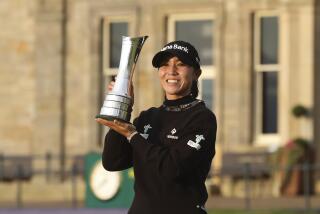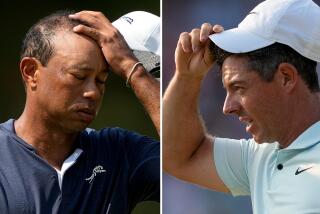Your Majors Stink!
- Share via
When Bill Rogers won the Open Golf Championship in 1981 at Royal St. George’s at Sandwich, he had no idea what the impact of that victory would be. He had crossed the Atlantic only because Ben Crenshaw convinced him he had to play in the championship at a venue where some locals were still living in houses built in 1300.
Sam Snead had dumped on the event in those austere years after the war, when he insisted that playing in the only Grand Slam event staged outside America was like “camping out” and that the Old Course at the home of golf was a cabbage patch. Of course, he comes from West Virginia.
It took Arnold Palmer and Jack Nicklaus to put things right with their loyal support of the event over nearly 40 years.
Had Rogers traveled the world as the U.S. Open champion or the Masters champion or the U.S. PGA champion, he would have commanded considerable respect, but as the winner of THE Open, he realized he was the world’s champion, feted even in places where he thought they had never heard of golf.
Nicklaus has always insisted that any golfer wishing to be taken seriously on the international stage should try to win THE Open. And he did it three times on courses very far removed from those lush and often artificial courses American professionals plod around week in, week out.
Playing in THE Open, the fairest test in golf, demands a whole new on-course strategy, a vivid imagination and a deft touch.
Tom Watson won THE Open five times between 1975 and 1983, to prove how adept he was at playing the crafty bump-and-run approach.
THE Open is not an event that relies on unfairly slick and cruelly undulating greens like the Masters, or on ridiculously penal rough like the U.S. Open. Neither does it stage its event at venues guaranteed most years to ensure mercilessly oppressive heat like the U.S. PGA each August.
It is THE Open because, quite simply, it was the first Open Championship.
Heck, the U.S. Open didn’t start until 1895, the U.S. PGA Championship was first staged in 1916 and the Masters is positively the new kid on the block, coming on the scene in 1934, 74 years after Willie Park, wearing his street clothes, won the first Open at Old Prestwick in 1860.
Run by the Royal & Ancient Golf Club of St. Andrews, the ruling body for world golf--everywhere except America, Canada and Mexico, that is--the Championship has a character all its own.
The golf is what matters, which is why many purists resent the intrusion of the exhibition centre and those noisy hospitality villages--thankfully, in Britain, kept well away from the fairways.
They are now part and parcel of any major sporting event, but what’s this? Tacky advertising banners on the stands! They compromise the dignity of THE Open.
What is certain is that THE Open has the most international of quality fields, the most historic venues, the most delightful trophy--an antique Claret Jug--the most knowledgeable spectators and the most polite officials.
It may all sound idyllic. It is. Where else could you hear an official on his walkie-talkie ask, in the most fruity David Niven-Rex Harrison accent, for a carpenter to be sent to the seventh fairway, where a spectator had broken a leg.
It was, of course, a wooden leg--but before signing off the official asked for one more favour: Would they put on the kettle so that he could have a cup of hot tea on his return to headquarters.
THE Open may be a world event, often staged in Scotland, but in some respects, it is still very English.
More to Read
Go beyond the scoreboard
Get the latest on L.A.'s teams in the daily Sports Report newsletter.
You may occasionally receive promotional content from the Los Angeles Times.










